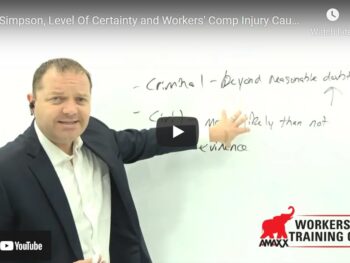Under any workers’ compensation act, an injury is compensable if it “arises out of” and occurs within “the course and scope” of an employee’s work activities. One area that is subject to frequent litigation is instance where an injury occurs during work breaks, or other non-work related activities. These personal comforts give members of the claims management team pause as to whether such an injury is compensable.
A Not So Uncommon Scenario
It is break time at the Acme Widget Company. Joe Friday missed breakfast and the company cafeteria is not yet open for lunch. Thankfully, there is a great coffee and donut shop across the street, which is frequented by employees before, during and after work. Joe decides to head over and grab a fresh jelly donut and cup of coffee. While carefully crossing the street he is struck by a car that did not stop for a traffic signal and suffers a broken leg. Would this claim be compensable?
Click Link to Access Free PDF Download
“How To Avoid, Manage, And Win Workers’ Comp Claim Litigation”
Understanding the “Personal Comfort” Doctrine
The “personal comfort doctrine is a legal principle created by the courts to address the nature of typical workplace environments. Under this doctrine found in most jurisdictions, employees can engage in activities to provide personal comfort and still be covered under the protections of a workers’ compensation act. Such common activities include using a restroom, smoking or coffee breaks, eating food and drinking non-intoxicating beverages.
Application of this doctrine varies in every jurisdiction. In reviewing such matters, courts will examine various issues. These factors include:
- Whether the activity was “contemplated” as part of the employment;
- The nature of the activity prior to the accident; and
- Any benefit to the employer when the employee engages in the activity resulting in injury.
Application of the Doctrine
Most workers’ compensation acts are interpreted in a light favorable to the employee. This result in injuries occurring during normal work hours, but off the employers premises or not directly related to one’s position, to be compensable.
Examples of injuries successfully using the personal comfort doctrine are numerous. In one example, an employee was crossing a street to get a pack of cigarettes. Although the injury did not occur on the employer’s property, the court found injuries similar to Joe Friday’s to be compensable. Holly Hill Fruit Products, Inc. v. Krider, 473 So. 2d 829 (Fla. Dist. Ct. App. 1st Dist. 1985).
The reasons for this finding include the following:
- The employee’s conduct was an “inevitable attendant danger;”
- The actions of the employee were conducive to a pleasant work environment; and
- While the employee was off the worksite for a short period, he did not remove himself from his employment activities.
Avoiding Unnecessary Workplace Exposures
Proactive members of the claim management team can work with interested stakeholders to reduce exposures and avoid “personal comfort” doctrine issues. Proactive steps can include:
- Providing or making essential items available to employees on the worksite or premises. This includes having refreshments available free of charge or at an on-site store. By doing so, they maintain more control of their worksite;
- Prohibiting smoking on company premises. Employers are recognizing the health benefits of tobacco-free workplaces. They can also coordinate with their health plan providers on accessibility of smoking cessation products or services to reduce the dependence on cigarettes; and
- Establishing clear company policies regarding departure from the company premise during the workday. This can include a clear statement that leaving the workplace for any non-work related reason removes them from their employment and workers’ compensation activities.
Conclusions
It is important for interested stakeholders to understand the “personal comfort” doctrine. This can assist with properly managing a claim where it is at issue and help employers minimize their risks to promote a safe work environment.
Author Michael Stack, Principal, COMPClub, Amaxx LLC. He is an expert in workers compensation cost containment systems and helps employers reduce their work comp costs by 20% to 50%. He works as a consultant to large and mid-market clients, is co-author of Your Ultimate Guide To Mastering Workers Comp Costs, a comprehensive step-by-step manual of cost containment strategies based on hands-on field experience, and is founder of COMPClub, an exclusive member training program on workers compensation cost containment best practices. Through these platforms he is in the trenches on a working together with clients to implement and define best practices, which allows him to continuously be at the forefront of innovation and thought leadership in workers’ compensation cost containment. Contact: mstack@reduceyourworkerscomp.com.
©2016 Amaxx LLC. All rights reserved under International Copyright Law.
Do not use this information without independent verification. All state laws vary. You should consult with your insurance broker, attorney, or qualified professional.











Some research is now indicating that narcotics may actually enhance pathways of pain in a very short time period. I’m sure these findings will be debated for some time but believe the day will come when narcotic pain control will be viewed as effective as bloodletting. The problem is, we have to get MDs to admit they’re wrong for having prescribed narcotics in the first place (or admit their predecessors were).
It can’t come soon enough for me. I’ve seen far too many cases where the claimant’s day is filled with taking their medication and watching television. With a lifestyle like that, you have to wonder how many overdoses were accidental.